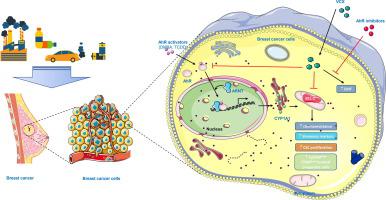Journal of Advanced Research ( IF 11.4 ) Pub Date : 2022-10-26 , DOI: 10.1016/j.jare.2022.10.006 Abdullah Al-Dhfyan 1 , Ayodele Alaiya 2 , Falah Al-Mohanna 3 , Mohamed W Attwa 4 , Abdullah F AlAsmari 2 , Saleh A Bakheet 2 , Hesham M Korashy 5

|
Introduction
Activating the aryl hydrocarbon receptor upon exposure to environmental pollutants promotes development of breast cancer stem cell (CSCs). BCL-2 family proteins protect cancer cells from the apoptotic effects of chemotherapeutic drugs. However, the crosstalk between AhR and the BCL-2 family in CSC development remains uninvestigated.
Objectives
This study explored the interaction mechanisms between AhR and BCL-2 in CSC development and chemoresistance.
Methods
A quantitative proteomic analysis study was performed as a tool for comparative expression analysis of breast cancer cells treated by AhR agonist. The basal and inducible levels of BCL-2, AhR, and CYP1A1 in vitro breast cancer and epithelial cell lines and in vivo mice animal models were determined by RT-PCR, Western blot analysis, immunofluorescence, flow cytometry, silencing of the target, and immunohistochemistry. In addition, an in silico toxicity study was conducted using DEREK software.
Results
Activation of the AhR/CYP1A1 pathway in mice increased EpCAMHigh/CD49fLow CD61+ luminal progenitor-like cells in early tumor formation but not in advanced tumors. In parallel, a chemoproteomic study on breast cancer MCF-7 cells revealed that the BCL-2 protein expression was the most upregulated upon AhR activation. The crosstalk between the AhR and BCL-2 pathways in vitro and in vivo modulated the CSCs features and chemoresistance. Interestingly, inhibition of BCL-2 in mice by venetoclax (VCX) increased EpCAMHigh/CD49fLow CD61+ luminal progenitor-like cells, causing inhibition of epithelial lineage markers, disruption of mammary gland branching and induced the epithelial-mesenchymal transition in mammary epithelial cells (MECs). The combined treatment of VCX and AhR antagonists in mice corrected the abnormal differentiation in MECs and protected mammary gland branching and cell identity.
Conclusions
This is the first study to report crosstalk between AhR and BCL-2 in breast CSCs and provides the rationale for using a combined treatment of BCL-2 inhibitor and AhR antagonist for more effective cancer prevention and treatment.
中文翻译:

芳烃受体 (AhR) 和 BCL-2 通路之间的串扰表明在 BCL-2 抑制治疗期间使用 AhR 拮抗剂来维持乳腺上皮细胞的正常分化状态
介绍
暴露于环境污染物后激活芳烃受体可促进乳腺癌干细胞(CSC)的发育。BCL-2 家族蛋白可保护癌细胞免受化疗药物的凋亡作用。然而,AhR 和 BCL-2 家族在 CSC 发育中的串扰仍未得到研究。
目标
本研究探讨了 AhR 和 BCL-2 在 CSC 发育和化疗耐药中的相互作用机制。
方法
进行了定量蛋白质组分析研究,作为对 AhR 激动剂处理的乳腺癌细胞进行比较表达分析的工具。通过 RT-PCR、Western blot 分析、免疫荧光、流式细胞术、靶点沉默和体外乳腺癌和上皮细胞系以及体内小鼠动物模型测定BCL-2、AhR 和 CYP1A1 的基础水平和诱导水平。免疫组织化学。此外,还使用 DEREK 软件进行了计算机毒性研究。
结果
小鼠中 AhR/CYP1A1 通路的激活增加了早期肿瘤形成中的 EpCAM High /CD49f Low CD61 +管腔祖细胞样细胞,但在晚期肿瘤中则没有增加。与此同时,对乳腺癌 MCF-7 细胞的化学蛋白质组学研究表明,AhR 激活后 BCL-2 蛋白表达上调最多。AhR 和 BCL-2 通路之间的体外和体内串扰调节 CSC 的特征和化疗耐药性。有趣的是,venetoclax (VCX) 抑制小鼠体内的 BCL-2 会增加 EpCAM High /CD49f Low CD61 +管腔祖细胞样细胞,从而抑制上皮谱系标记物、破坏乳腺分支并诱导乳腺上皮细胞的上皮-间质转化。细胞(MEC)。VCX 和 AhR 拮抗剂联合治疗小鼠可纠正 MEC 的异常分化,并保护乳腺分支和细胞特性。
结论
这是第一项报告乳腺 CSC 中 AhR 和 BCL-2 之间串扰的研究,并为使用 BCL-2 抑制剂和 AhR 拮抗剂联合治疗以更有效地预防和治疗癌症提供了理论基础。











































 京公网安备 11010802027423号
京公网安备 11010802027423号